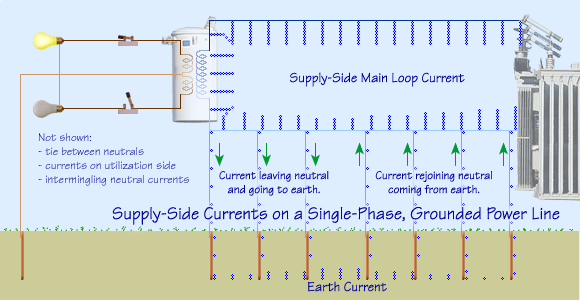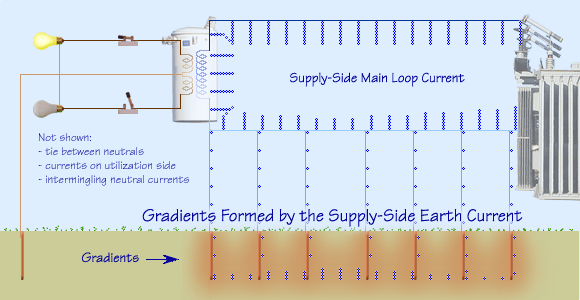Supply-Side Gradients |
|
|
|
As we have learned, there must be a closed electrical loop in order to transfer (move) electrical energy. The current that goes to an electrical load must return to its source. On a utility distribution system, most of the current returns to its source (the substation) by way of the primary neutral conductor. Voltage gradients form in the earth along a power line when the conductor
carrying the return current is grounded. The formation of these gradients
cannot be avoided because
their presence is dictated by physical laws.
These laws require that some current,
however small, will flow through the earth. The resulting gradients are typically
very small, well below the perception level, but on some occasions can rise to levels
of concern. |
|
The portion of the return current that flows through the earth rather than on the primary neutral conductor
depends on the resistance presented by the neutral wire and how it compares to the
resistance presented by the earth. The splitting of current between two alternate
paths, each of a different resistance value, is also dictated by physical laws that
cannot be avoided. |
 
|
|
In an ideal case in which the neutral conductor had no resistance,
there would be no earth current component. All of the current would flow on the zero resistance conductor.
But no conductor exists in real life that has no resistance at all,
except for
superconductors which
are not yet in use outside of research labs.
All conductors, no matter their physical size,
have some resistance to the flow of electrical current (including
reactance on AC systems).
We can approximate ideal conditions by utilizing conductors that have very low
electrical resistance, such as copper and aluminum, and sizing them appropriately and cost-effectively.
This approximation reduces the gradients to insignificant levels, but does not
eliminate them completely.
|
 
|
|
The following figure is a simplified illustration of the neutral current distributing itself
along the supply side-circuit. Some of the neutral current flows through the earth for
portions of its route back to the substation rather than on the neutral conductor itself.
This distribution pattern is similar to automobile traffic making use of side roads when a highway becomes crowded.
|





|
 
|
|
|
|
The earth current creates the supply-side gradients in the earth.
Some utilization-side earth currents can flow on the supply
side circuit, as we shall see later. However, these additional earth currents
do not change the main character of the supply-side gradients as presented here.
Their effect will be considered in a later section
[Intermingling].
|
|
The next figure illustrates the formation of gradients along the supply side of the
power system. |





|
 
|
|
The supply-side gradients are made up of the two types of gradients
previously discussed in the two-rod study case [What is Gd?].
They are the field gradient, present along the entire length of the power line
[Field Gd], and the localized spreading gradient
around each ground rod [Spreading Gd].
These two types combine to form the supply-side gradients
[Combined Gd].
|
|
|





|
